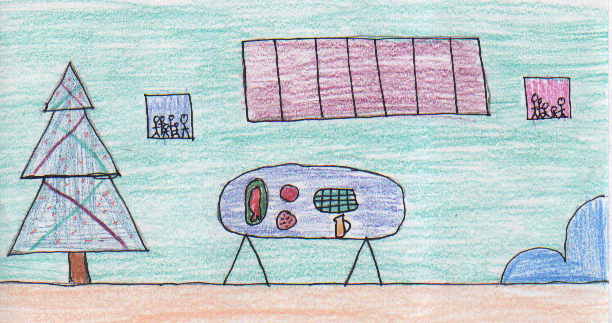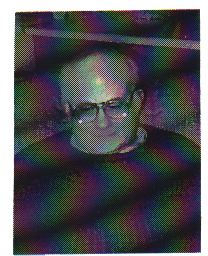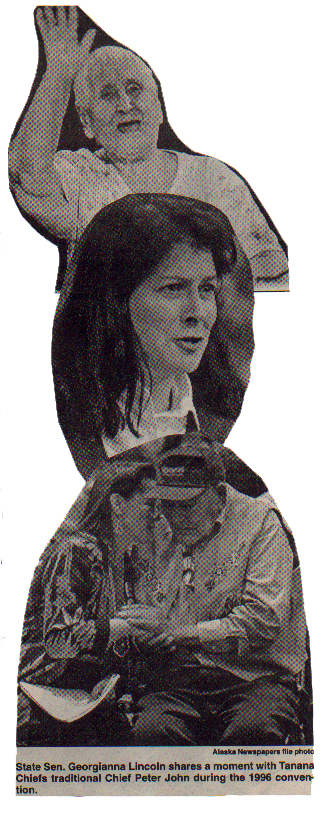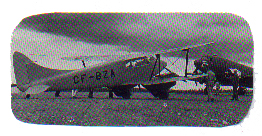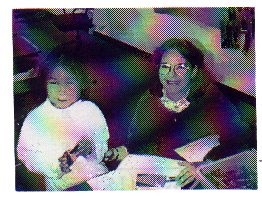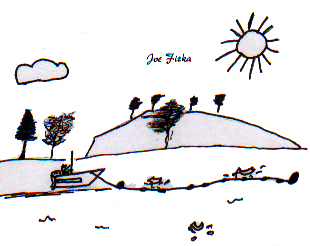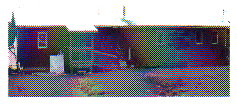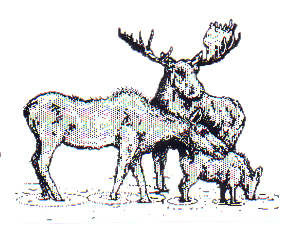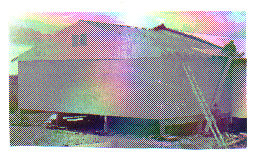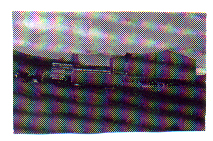 This collection of student work is from Frank Keim's classes. He wants to share these works for others to use as an example of culturally-based curriculum and documentation. These documents have been OCR-scanned and are available for educational use only.
This collection of student work is from Frank Keim's classes. He wants to share these works for others to use as an example of culturally-based curriculum and documentation. These documents have been OCR-scanned and are available for educational use only.Special | A | B | C | D | E | F | G | H | I | J | K | L | M | N | O
P | Q | R | S | T | U | V | W | X | Y | Z | ALL
F |
|---|
Fair Weather Camping:Fair Weather Camping
One time in mid-April when the weather was nice and warm, Agnes and Alvin Owletuck went camping behind Mt. Pilcher in Kayakutaq. Their daughter, Clara, was about six years old, and she was their only child at the time. They traveled back there by dog team, and would also hitch a small sled up to six pups for Clara who traveled alongside them. This was the time before snowmachines were invented, she said. It took them a total of four hours to go and come back. The pups would run alongside the older dogs. It was very nice and warm, and it was always fun because it never rained. Agnes remembers another time when she went salmon berry picking in July above Pilot Station in a slough where there was an old cabin. While they were picking their berries they stashed their camp gear inside the cabin. The weather was nice and clear, and the breeze was just right. Altogether they picked more than ten gallons of salmon berries. Agnes said she really never enjoyed wet, rainy days because it was so glum! By: Agnes Owletuck Interviewed by: Carmen Pitka  | |
|
Fair Weather Camping:Fair Weather
Camping
One time in mid-April when the weather was nice and warm, Agnes and Alvin Owletuck went camping behind Mt. Pilcher in Kayakutaq. Their daughter, Clara, was about six years old, and she was their only child at the time. They traveled back there by dog team, and would also hitch a small sled up to six pups for Clara who traveled alongside them. This was the time before snowmachines were invented, she said. It took them a total of four hours to go and come back. The pups would run alongside the older dogs. It was very nice and warm, and it was always fun because it never rained. Agnes remembers another time when she went salmon berry picking in July above Pilot Station in a slough where there was an old cabin. While they were picking their berries, they stashed their camp gear inside the cabin. The weather was nice and clear, and the breeze was just right. Altogether they picked more than 10 gallons of salmon berries that day. Agnes said she really never enjoyed wet, rainy days because it was so glum! By: Agnes Owletuck  | |
|
Fair Weather Hunting: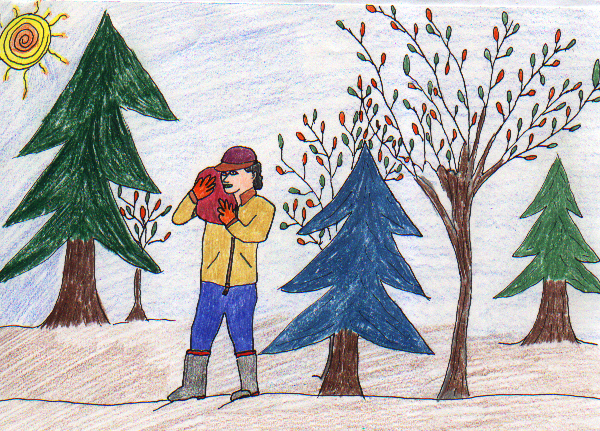 Fair Weather Hunting In mid-September Nick and Charlie Fitka, and John Riley Sr. left by boat for moose hunting above Holy Cross. The weather was nice, and it was only a little breezy out--just the way they liked it. They all traveled in one boat with all their camping gear. The ride upriver was like any other boat ride and took them about five hours to get to Paimiut where they made camp for the night. It didn't take them very long to find and kill a couple bull moose. They also saw some cow moose with their calves. During the nights they were out the weather would get a little cool but other than that it was nice. Their tent kept them warm, and when they ran out of food they went shopping at one of the stores at Holy Cross where they also visited people they knew. When they returned home Nick, Charlie and John came in with big chunks of moose meat and moose ribs. Nick enjoyed the hunting trip, and said the only tough part about it was carrying big pieces of moose through trees and willows. But the weather was fine--just the way they always like it. By: Nick Fitka Sr.Interviewed by: Carmen Pitka | |
|
Fake Bear Story by Greg Evan:If I was a grizzly bear for the summer I would walk around the tundra and go hunt. I would climb heap big mountains. And I would fight little bears and moose. I would run away from the hunters. I would play with my little buddies, Rabbit, Moose, and with my brother. We would play Kick the Drum and Red Rover. My mom's name is Big Blob. My name is Heap because I say heap all the time, and my brother's name is Upa because he looks so old. We like to play wrestle and we beat the living daylights out of anybody that bothers us. We listen to Big Blob so we can get food. If a big ugly male comes along my mom will drown him. In winter we take a big sleep. By Greg Evan
| |
|
Falling Through the Ice: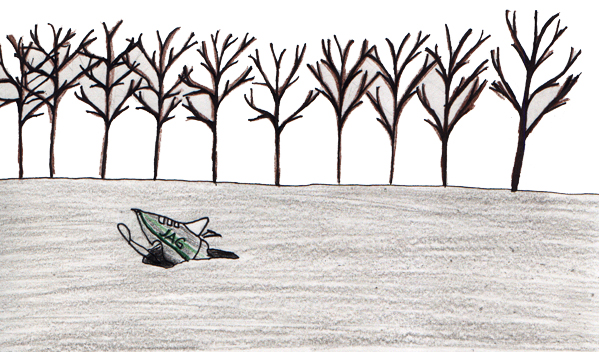 "Falling Through the Ice"
When my dad was younger there was no modern transportation, and he always had to travel with his dog team. In those days he lived at the old village of Ohogamiut. He told me that one time in January, 1946, when it was 30 degrees below he was traveling by dog team in Nuksuk Slough near Ohogamiut. While he was crossing he and his dogs fell through thin ice. He said the sled tipped to one side then he fell in the frigid water. He noticed his dogs were going down with him so he let them go. When he felt the bottom the water was up to his neck. He walked toward the edge of the solid ice, placed his mittens on the surface where they froze in place, then he pulled himself out of the cold water before he got too numb and tired. After he got out of the water he quickly gathered some nearby grass and stuffed it inside his wet clothing to keep him warm. That saved his life. Another time was in spring, 1989, when Alexander Isaac and my dad went out goose hunting with their snowmachines. While they were coming back on the Yukon River, my dad fell through the ice. He was crossing some needle ice over a swift running part of the river and the ice broke. The current would have taken him under with his snowmachine but he was lucky there was another thicker layer of ice underneath that caught the end of his snowmachine and kept him from going all the way under. So he wouldn't be swept down by the current he hung on to his machine. He was able to stay afloat thanks to his down coat. Alexander quickly threw him a rope and he crawled out. As soon as he got out my dad and Alexander found some long skinny pieces of wood and put them under his snowmachine so they could pull it out.
By: John Moxie Interviewed by: Olga Moxie | |
|
Family Christmas Dreams:Family Christmas
Dreams
My dream Christmas would be having my whole family together here at home, including the many children adopted out of the family and also the relatives that have already passed on. We would all be piled into my Gram's house: my uncles, my aunties, my cousins, and all our children. My Gram and my Uppa would have liked to see all their grandchildren's children. We would all be there eating a very big Christmas dinner. After we were through eating, we would all help each other clean up and watch each other's children. When we were through with that, we would all sit around a big, fat, beautifully decorated Christmas tree laughing, talking and watching each other's kids open their presents. Everyone would be sober and drug-free and having a good time without alcohol or anything else. After taking pictures of each other's kids and of our families, we would put our kids to sleep. Then we women would stay up talking while the men would be off doing their own things. The next morning we would all plan activities for us and our kids to do. We would all spend the day together having lots of fun. Then in the evening after resting and taking maqis, we would all go square dancing. By: Gerilyn Fitka
| |
|
Father Ed's Busy Vacation:Father ED's Busy Vacation
Father Ed didn't have much of a vacation because he was busy working on the new church down in Pilot Station. He moved a lot of stuff around there and got ready for Christmas mass, both midnight and morning masses, which were held in the new church. He also stayed in Marshall in Frank Keim's house while they were visiting their parents in Kansas and Ontario. He liked staying there with Frank's dog, Buddy. He and Buddy would take walks regularly to the airport and back. Most of the time Buddy and his friend, Prunes (David Andrew's dog), would play with Ed while they walked. He says that they were fun to watch. He also participated in the Russian Othodox Chrismas by eating at different houses where the star was at the time. Father Ed said he also had to travel down to St. Mary's for a meeting, and going back and forth was a little bit trying at times. By: Father Ed Flint Interview by: John Tikiun Jr.
| |
|
Feature News:Feature
News
School Begins With A
Bang
It has begun!! Not another fire, not bingo...SCHOOL! Once again, on August 18 at 8:50 Monday morning, school started. Every student from age 5 to 18 was out of bed, wide awake and ready to learn. Before school could begin, though, some school projects had to be done. They were completed during the 2 1\2 month summer vacation. Our new maintenance man, Nick Duny, and his two helpers, custodians Paul Boots and Katemal Shorty, and a couple of SYETP workers "straightened-up" the school over that short period of time. Some of the things that were done were: painting the hallway and the classrooms, making an arctic entry in the northwest side of the school building, shampooing and repairing the carpets in the classrooms and switching the lockers so that the high school and elementary students will have an easier time getting to their lockers then to their classes. Some of our little playground "buildings" and "bus" were also painted. Traci Fitka, SYETP coordinator, had two of her workers, Walter Tikiun and Lois Moore, painted the two "buildings" light blue and the "bus" an almost bright yellow. Some of the projects that still need to be done are: fixing up the teachers workroom, fixing up the basketball court outside, and installing heaters in the gym. Some of these projects will be done this year and some next summer. The school will also be receiving a new bike rack so, if kids come to school with their bikes, they won't be scattered all over the school property. Max Lunt, the principal, thinks that the students of Marshall School will do well in their classes and that we will have a good year. In the 1995-96 school year, the students ranked 7th in the District in attendance. Last year we ranked 4th. Max hopes that this year we will lead the district. So, Marshall students, let's try not to let him down. Let's take care of our school and try to be here every weekday.
Student Teacher Flora
Evan
"It's the beginning of the end for my college years and my student career in the field of Secondary Education. By this, I mean, I have completed all my course requirements with the exception of Student Teaching. My Bachelors degree is concentrated on Language Arts. I attended Sheldon Jackson College in Sitka for four years. For my final semester, I am student teaching at the Marshall School. To broaden my range and variety of teaching methods, I am working with Richard Olsen and Frank Keim, my host teachers. I am working with Richard Olsen's ninth and tenth grade English class where we started the year with a novel. I am also working with his Junior High English class in which we are working on reading and writing. Frank Keim's Journalism and Russian classes are the other classes which I am working in. My requirements during student teaching are to construct lesson plans and present them to the students. My host teachers also have to complete a Teaching Skills Analysis Form (TSAF) while I am doing my lesson. The TSAF is used for feedback on how I presented the lesson and my strengths and weaknesses. The semester started off well, and I thank Richard Olsen, Frank Keim, and the Marshall School for allowing me to student teach in Marshall."
Marshall's New
Airport
Pilots will soon have a new airport to land on.The people of Marshall had complaints about the old airport being in a place with bad crosswinds. So they votedon a new site for the airport. There were four different sites where the airport could be located. The choices were on top of the hill to the northeast or across from Wilson Creek. Since people chose the one across from Wilson, the engineers from the Department of Transportation took test samples of the soil from there. If the tests are good, then the new airport will be made there. The new airport will be approximately 4400 ft. long, and the layout will be according to the prevailing winds. Some people asked why it would not be closer to the present airport or why the one we have now couldn't be extended. The answer was that the land wasn't available because it was privately owned. With the airport being 4400 ft. long, it will probably take two years to be built and ready for use. The airport will also be big enough for large cargo planes to land on and bring heavy equipment in for the people in our community. Jets won't be able to land here, though. Sometimes in other villages the airport is open to the community only at certain hours of the day, but there will be no such restrictions to the new airport here. It will be open all hours of the day and night. Tassie Fitka
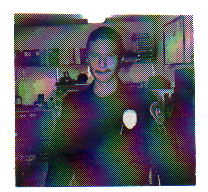
Jason Isaac, New V.P.O. Jason Isaac Is our new Village Police Officer (V.P.O.). Four months ago, Jason finally realized his dream when he was hired by the City of Marshall as our V.P.O. Jason's salary is paid by the city through the three year $150,000.00 Federal Cops Grant which also pays our other V.P.O. Walter Pitka. Jason wanted to become a V.P.O. for some of the same reasons that little kids want to become troopers, fire fighters, or V.P.O.'s. In elementary school he watched these people and thought they looked cool. He admired them and wanted to be just like them. The responsibilities of a V.P.O. may be hard or easy, according to V.P.O. Isaac. For him, though, being a V.P.O. is not too hard. He has to enforce all of Marshall's ordinances and the Alaska State laws. He makes sure everyone is home at their curfew time, and he makes arrests when it is necessary. V.P.O.'s generally receive training but Jason says he hasn't gotten any training yet. He and other V.P.O.'s will be going to St. Mary's, though, for their annual training in October. As a V.P.O. Jason has to know a little first aid and about gun safety which he will learn then. Maurice Turet
Two New Teachers for
Marshall
Guy and Barb Sandlin are new teachers here are Marshall School. They were last teaching down at Alakanuk School. Guy is teaching 7th, 8th, and H.S. grades, and Barb is teaching 1st and 2nd grades. Both Guy and Barb responded that Alakanuk was a good school, but a lot bigger than Marshall. They both have been teaching for 30 years. The places they taught were Arizona, Hawaii, Montana, and here in the L.Y.S.D. Guy went to several Colleges. He got his teaching degree at Arizona College. His majors are Math and Genetics. Barb also went to Arizona College and her major is Elementary Education. Both of them stayed in school for 4 1/2 to 5 years. Guy always wanted to be a teacher. He thinks being a teacher is a rewarding and fun way of helping students. Barb wanted to be a teacher because when she was young she had a horrible teacher, and she felt she could be a good teacher. Guy's favorite subject is math, and Barb's favorite subject is reading. Both of them think that Marshall High School is just right and a wonderful place to be. They are planning on teaching for another 4-5 years. "I'll teach as long as I love it," says Barb.

Fishing The Yukon
Fishing in Bristol Bay and on the Kuskokwim River was a bust, but some Lower Yukon fishermen told a different story. Many Lower Yukon commercial fishermen said this has been a good season for Kings. One of the fishermen who had a profitable season is Garrett (Loots) Evan. He has had a very pleasing fishing season. At only 19, Loots is one of the youngest permit holders on the Yukon. He has been fishing as a helper since he was ten years old. Loots just got his permit last year and he is already a good fisherman. Most fishermen didn't have the luck that Garrett had. One fisherman says that he had a devastating season. It just goes to show you that fishing on the Yukon differs from spot to spot. Joe Fitka The Marshall Health Clinic has a new addition. It is named after one of the past health aides, Theresa Elia. The clinic was moved from its old location in 1985 taking the trained health aides with it. It was moved from beside the old Catholic Church to its present location beside the school building. The City of Marshall decided to build a new clinic because the old one was a very small building. Carpenters recently built an addition to the present clinic so more patients can be seen if the other rooms are filled. The two exam rooms they had were not enough. There are many other new rooms that were added to the clinic. There is enough room now to make a kitchen and a storage room, and it even has space for any big emergency that may occur. There are also bedrooms for the doctors and nurses who come to Marshall to check patients. In plain words, the health aides here in Marshall say it takes dedication and devotion to be a health aide. To become a health aide you have to take a lot of training in many different areas. There are certain steps you have to follow and four sessions that are required. During classes instructors teach you about human anatomy, different diseases and how to treat them, pregnancy and child birth, and how to deal with death and dying. You have to know what to order, such as prescription drugs and supplies you need. A health aide works six hours a day and thirty hours a week. The Yukon Kuskokwim Health Corporation (YKHC) is the parent organization of the clinic. That is where all the records of past medical histories are kept. YKHC is where Oxie, Liz, and Augusta report the patients they have seen. Whenever the clinic is short of supplies like medication they get it from the YKHC. Doctors, nurses, and dentists visit the village once a year to make sure everything is okay. The health aides like the jobs they have. Although they have to learn lots of different things and know how to handle the large amount of responsibility, they say it gives them a lot of self-satisfaction.
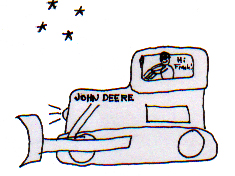
A New Land Fill for Marshall Hey, all you Marshall dumpers! There's going to be a new landfill on the tundra. The people chose the new dump site to be built out there on the tundra. The new dump is built 300 ft. x 300 ft. and is designed to last for about 14.6 years. If the paper trash is burned it should last even longer. They built it this way to conform with rules and regulations made in Juneau and Washington, D.C.! They started construction in August, 1995, and they plan to finish the dump by September, 1997. It is now actually pretty much finished. They just need to install a fence and put down a lining so it won't leak. When it is all filled up with trash they will cover it up with gravel. They are going to buy a garbage truck so they can start a garbage pickup service. They are also going to build an incinerator so they can burn the paper trash. They will recycle some materials like batteries, pop cans, etc, and they will have a salvage yard where people can get old parts from three wheelers, four wheelers, snow machines, etc. For the city to pay for all this there will be an extra charge on everybody's water bills or they could pay for it with a city sales tax. When people come from other places for races, 4th of July or other big events they would help pay for the costs of water and sewer service and garbage collection through a sales tax.
Marshall has a New Catholic
Church
Six or seven years ago the Parish Council of Marshall, Agnes Owletuck, Alvin Owletuck Sr., Lorraine Fitka, Angeline Coffee, and a couple of others decided to build a new Catholic Church. They had problems deciding on the location of the new church because of land claims. But finally last year they got the materials for the new church. Paul Perreault, an architept, drew the design for the church. It has two bathrooms, a bedroom, storage room, and two kitchens. The upstairs is the living quarters for the priest. Last year when they first started construction they had five volunteer workers: Paul Coffee, Andy Boots, Shawn Thompson, Fred Fitka and Alvin Owletuck Sr. Shawn was the supervisor who helped work on the building with the four other men. Alvin, Fred, Paul and Andy worked on and off for three months. It took all five of them three months to put the building up. The total amount of cash that was put into the church was $40,000.00. A rich old lady from the Lower 48 donated the money to the Marshall Catholic Church. The Catholic Extension Society used the money to get the materials needed to build the church. This year a few volunteers worked on it too. It's almost done but still needs some work done on the inside. The people working on the church need to wait for some papers so they can finish their work. The new church is a lot better than the old church because it is bigger and has more room inside. After the workers are done building the new church they are going to knock down the old church and use the materials for other projects.
Fires Rage on the
Yukon!
Fires raged near Russian Mission this summer. According to Tom Soolook, these fires were located ten miles northeast of Russian Mission. Altogether ten crews from Alaska fought fires which burned 3,300 acres just outside of Russian Mission. The first week the firefighters had to walk toward the fires, but they had one problem. Most of the crew members were getting blisters on their feet. Then the next week they were transported by a helicopter to the fire. They used pulaskies, shovels, chainsaws and water to burn out the fires. The hotshot crews, also called "The North Stars," mopped up the fires after the other crews left. While fire fighting two people got injured. One man from Stebbins got stung on his lips twice by bumble bees. Another person cut his leg with a pulaski. Tom Soolook has been fighting fires ever since 1988. This year he fought fires for 18 days, from July 19 to August 5. This was the longest time he ever spent fighting fires. Jon Boots
| |
|
Feature News:Feature News
A Good Moose
Season
The moose season started September 1, 1997, for all the hunters on the upper and lower Yukon River. Mike Duny, a hunter from Marshall, says that his moose season was short but okay. It didn't take him long to catch a moose the day he went out hunting with Roy Fitka. They went up to Tucker's Slough above Russian Mission early in the afternoon. When they reached their destination they saw two big bulls swimming across the slough and waited until they got closer to the beach. When the two bulls were close enough, they shot them, pulled the moose up the beach and skinned them. Roy and Mike came home the following day. Fred Fitka's moose season was also good and he had fun, he said. He went out with Willie Duny to Paimuit, located about 120 miles from Marshall, for a couple of days. He caught his moose a day after Willie caught his. When Fred was hunting his moose they had to run after it in the trees for a while. Fred and Willie couldn't find it at first, so they had to camp. They were going to go in but the grass was about 5' 7" and they couldn't see above their heads. They stood on logs and still couldn't see. They waited until the next day, and they finally found it in the cottonwoods. It took them seven hours to pack the meat out from the cotton woods to Fred's boat. "This year's Moose season was alright, but there were too many gnats and a lot of bugs," says Moe Duny, another Marshall Hunter. He got his moose the first day the season opened in Unit 21 at Big Bend. The first night he camped at Paimuit, and the last three nights at Big Bend (Horse Island) about 5 miles below Holy Cross. Moe and others had their camp below Nick Andrew Sr., Alvin Owletuck Sr. and Joe Uzulook. After he caught his moose, he went home and put the meat away for winter.
Tank Farm Being
Relocated
There are changes in store for the old tank farm. Mas. Inc. and the City of Marshall plan to move the tank farm so that it will be in compliance with State and Coast Guard regulations. They plan to use the same tanks that Mas. Inc. already has and will start on the project during the summer of 1998. Local people will work on the project. They are going to use double walled fuel lines and they will be all welded with no thread connections. They are going to work with the Department of Environmental Conservation to make sure there are no leaks. Also to ensure this they are going to put double line dikes around each tank.
Willow Mine to be
Mined?
The old Willow gold mine has been up there since the days of the gold rush in the early 1930's. It is located about four miles above the Yukon River on Willow Creek on the other side of Mt. Okumiak. According to Roberta Fitka, there was a guy interested in developing the mine last year (1996). There are also some people in Marshall who are interested in developing the mine. Some people here voted for the new airport to be located on the other side of Wilson Creek so they would have a free road closer to the mine. But nobody is really sure where the airport's location is going to be. If the state builds an airport on the other side of Wilson Creek they might extend a road to the old mine. But they are still not quite sure about anything. One thing people are really concerned about is whether there is mercury up at the old mine. If there is mercury up there it could be very dangerous. The mine has been assayed for valuable minerals, but so far geologists who did some tests last year have found only iron ore. The old mine is presently on Mas. Inc. Corporation land. Some of the original miners used to own part of that land, like Gene Tetinek and Bill AlIman. Bill AlIman had a claim up there and he gave his building to the Mas. Inc. Corporation. Gene Tetinek gave his house to the school in Marshall. All the people who once owned land at the mine are now deceased. Nobody has any plans to sell or buy the mine yet. If anyone wanted to buy the mine it would cost them a lot of money, even though nothing valuable has been found up there yet.
Marshall Co-op Store
Extension
The purpose of the 20' x 30' extension at the local Co-op Store is to increase and improve office space and also to add water and sewer to the building. The whole project will cost about $46,000. The costs are: $25,000 to get the lumber and materials to Marshall, $10,000 in labor, and $11,000 to hook up the water and sewer. There are four guys from Marshall now working on the Co-op extension. Leo Fitka, the foreman, is in charge of getting the extension up, and he also assigns the laborers their different jobs. There are three laborers, and they will be changed when they have worked for three weeks so more people can have a chance to work in town. The manager of the Co-op Store, Willie Fitka, says it will probably take only three to five weeks to complete the extension because the workers are building it at such a fast pace. According to Willie, the Co-op is also going to have a neon sign which will read "Fortuna Ledge Co-op Native Store". Charlotte Alstrom
Marshall's New Armory
The Alaska National Guard is building an armory on the south side of the road going to the new dump site. It is located right behind Leo Fitka's house and is to be used for storing supplies and training National Guard soldiers. The two men who are working on the armory are Tim Mahoney and Dave Ward from Wasilla, Alaska. Tim and Dave are working for Cook Inlet Construction Inc. They are staying at Hunter Sales until the project is completed. They started building the armory on September 16th, and they hope to complete the structure on November 15th. The building is going to be heated by a monitor heater and an oil-fired heater. Tim says that he and Dave like it here because of the friendly people and nice location. Maurice Turet The recent news on the airport project is that two archeologists recently did surveys to determine if there is any evidence of prior occupation. Somebody also said that state surveyors drilled twenty-two feet down and still didn't hit any bedrock. Ray Alstrom says there are no State requirements for the construction of the airstrip on tundra. He says they have technology that allows construction of the airport above the permafrost. Before they build a bridge over Wilson Creek, though, they have to do surveys on the salmon that spawn there and they have to go through the Dept. of Fish and Game and the EPA to do these. The kind of studies that have to be done are to see if the bridge would interfere with fish spawning. Ray says that the Department Of Transportation will be building the airport on the other side of Wilson Creek because that is where it was chosen to be built by the village. Land ownership problems prevent it from being built above the present airstrip, even though that is a more convenient place for it to be built. Tatiana Sergie
Marshall Head Start
Begins
The Marshall Head Start began their school year on September 10th, 1997. There are 18 students attending the Marshall Head Start and they are: Nadia Fitka, Ryan Fitka, Daniel Fitka, Kristie Alstrom, Shaun Alstrom, Shawna Pitka, Kaelyn Fitka, Freida Sergie, Sophianne Sergie, Vassily Sergie Jr., Arthur Fitka II, Maxine Fitka, Thomas Soolook Jr., Zachery Andrew, Beverly Owletuck, Allison One, John Coffee and Darien Evan. Their teachers are Fran Evan and Barbie Fitka-Duny. The nine kids who are going to graduate this year are the four year olds. They are: Shaun Alstrom, John Coffee, Darien Evan, Aurthur Fitka, Maxine Fitka, Shawna Pitka, Frieda Sergie, Sophianne Sergie and Ryan Fitka. They will all be five years old when they graduate. This year the Head Start teachers are teaching the kids what their parents want them to learn, such as things about their culture, sharing, listening, taking turns,following directions and signging. One interesting topic that the kids are learning is about their culture. Nick Isaac, Marshall School bilingual teacher, is teaching them a few Yup'ik words, and the kids are enjoying it. Another thing that the kids enjoy doing is coming up to the Big school during play time to use the gym. There are 18 students in the little red building we call the Head Start, and two teachers who teach them what they need to learn before they can become Kindergardeners. Nine of the 18 students will be graduating this year and Barb expects the same amount, or more, of kids for the next school year.
Marshall Traditional
Council
Dolores Hunter is the Administrator for the Marshall Traditional Council. The Marshall Traditional Council is there to operate and maintain affairs that have to do with the federal government, such as land, subsistence, human services and certain aspects of education. Dolores is working through the Marshall Traditional Council on projects relating to the Indian Child Welfare Act (ICWA), Small Tribes, Kuigpagmiut and the Environmental Protection Agency (EPA). There are other people also working on each of these projects except for the ICWA program. Sophie Tiffert is working with the Small Tribes Program which tries to find employment for local people. Jacob Isaac works with the Enviromental Protection Agency (EPA) on a project to keep Marshall clean. No one has been hired yet to work with the ICWA program which requires a lot of family conflict resolution. Tassie Fitka 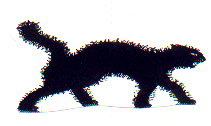 | |
|




